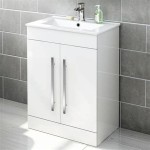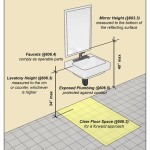Essential Aspects of Typical Bathroom Sink Depth
The depth of a bathroom sink is a crucial factor that affects both functionality and aesthetics. It determines the amount of space available for washing hands, brushing teeth, and other daily tasks. Additionally, the depth can impact the overall design of the bathroom, affecting the placement of fixtures and the flow of the room.
In this article, we will explore the essential aspects of typical bathroom sink depth, providing insights into the factors that influence the depth and the implications for bathroom design.
Factors Influencing Sink Depth
Several factors influence the depth of a bathroom sink, including:
- User Height: Taller individuals may prefer deeper sinks to avoid splashing, while shorter individuals may find shallower sinks more comfortable.
- Countertop Height: The height of the countertop will determine the distance between the sink rim and the bottom of the sink bowl.
- Faucet Type: High-arc faucets require deeper sinks to accommodate the water flow without splashing.
- Storage Needs: Deeper sinks can provide more space for storing toiletries and cleaning supplies beneath the sink.
Depth Ranges and Implications
Typical bathroom sink depth ranges from 6 inches to 9 inches. However, the optimal depth will vary depending on the factors mentioned above.
- 6-7 inches: These shallower sinks are suitable for smaller bathrooms and for individuals who prefer a more minimalist look.
- 7-8 inches: This is the most common depth for bathroom sinks, providing a balance between functionality and aesthetics.
- 8-9 inches: These deeper sinks offer ample space for washing and storage, but may not be suitable for individuals with limited reach.
In addition to depth, the shape of the sink bowl can also impact functionality. Round basins are typically deeper than oval or rectangular basins, providing more storage and splash resistance.
Design Considerations and Trends
Bathroom sink depth should be carefully considered in the overall design of the bathroom. It should complement the style of the bathroom and the other fixtures. In contemporary bathrooms, shallow sinks are often paired with floating vanities to create a sleek and minimalist look.
In traditional or transitional bathrooms, deeper sinks can add a touch of elegance and provide more storage. Undermount sinks, which are mounted below the countertop, can create a seamless look and increase the available counter space.

What S The Standard Depth Of A Bathroom Vanity

Standard Bathroom Sink Dimensions With Photos Upgradedhome Com

Ruvati 16 In X 11 Undermount Bathroom Sink Brushed Stainless Steel Rvh6107 The Home Depot

What Is The Standard Height Of A Bathroom Vanity Sizes Vessel Sink Cabinets

Bathroom Sink Dimensions And Guidelines With 3 Drawings Homenish In 2024 Sizes

Basin Sizes Toilet Shower Enclosure Bathroom Dimensions Durovin

Standard Bathroom Vanity Dimensions With Photos Upgradedhome Com

Native Trails Trough 36 Rectangle Nativestone Concrete Bathroom Sink

Bathroom Sinks China Top Sink For Petite Style Vanities By Diamond Fixtures Kitchensource Com

Top 45 Useful Standard Dimensions Engineering Discoveries Bathroom Interior Design Plan Guide
Related Posts







